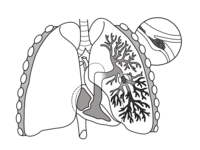
Photo from wikipedia
Objective To analyze prevalence of venous thromboembolism (VTE) after ultrasound guided foam sclerotherapy. Method Clinical retrospective study with patients treated from 2004 to 2014. Charts with incomplete data and follow-up… Click to show full abstract
Objective To analyze prevalence of venous thromboembolism (VTE) after ultrasound guided foam sclerotherapy. Method Clinical retrospective study with patients treated from 2004 to 2014. Charts with incomplete data and follow-up less than 60 days were excluded. Polidocanol foam (Tessari method) was used. The primary outcome was the prevalence of VTE and the secondary were possible risk factors. Chi-square test and Marascuillo prodecure were applied at a significance level of 5%. Results 2,616 patients were included with 4,712 lower limbs treated. The mean age was 50.7±0.86, in majority female, 83.7%. VTE occurred in 0.49% (pulmonary embolism 0,3%) in a mean time of 44.0±42.2 days. Male gender, personal or family history of phlebitis or DVT and high caliber varicose veins were significantly associated to VTE. Conclusion incidence of VTE is low, male gender, personal or family history of VTE and caliber of varicose veins greater than 7 mm increased the risk.
Journal Title: Phlebology
Year Published: 2020
Link to full text (if available)
Share on Social Media: Sign Up to like & get
recommendations!